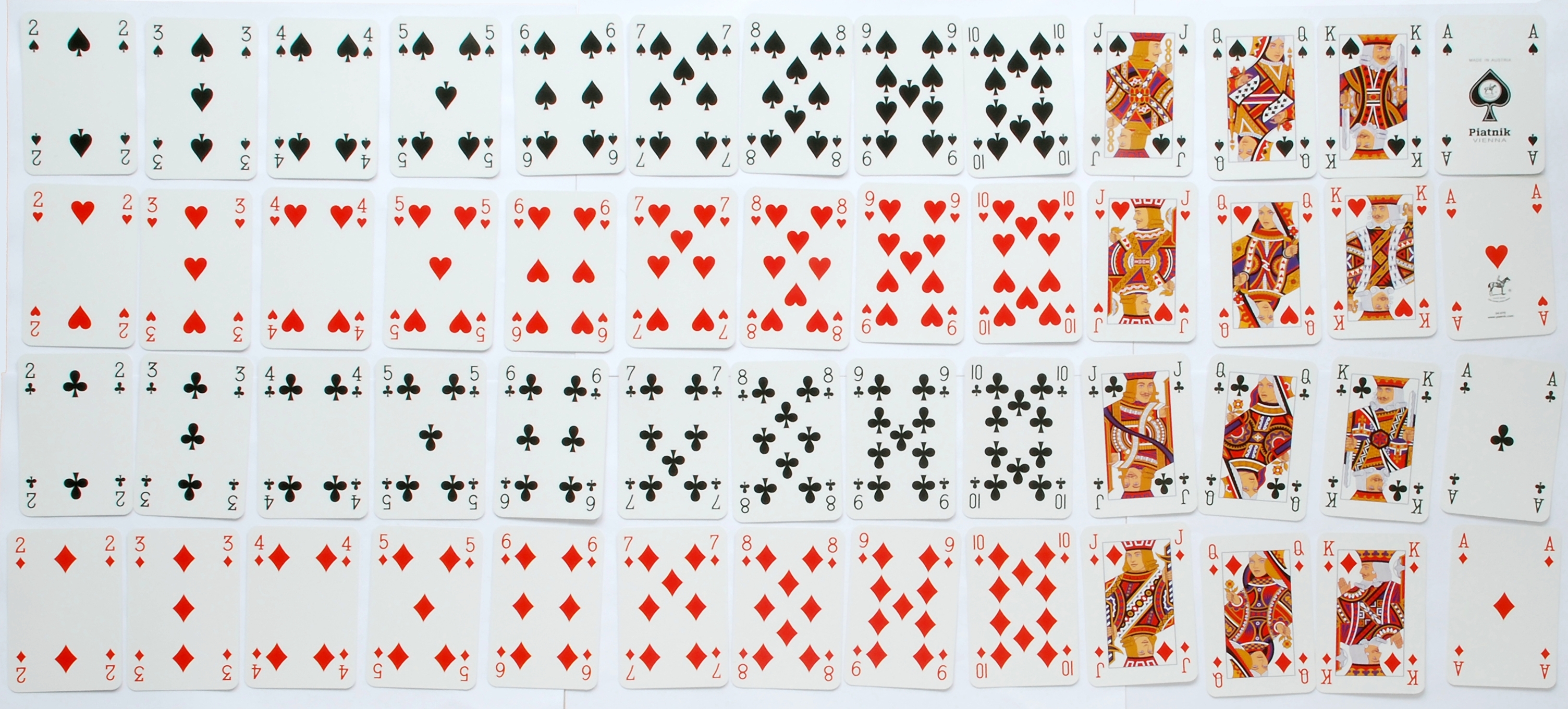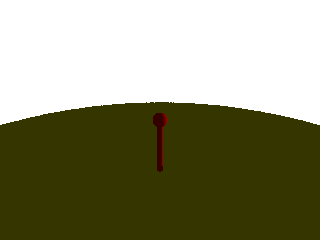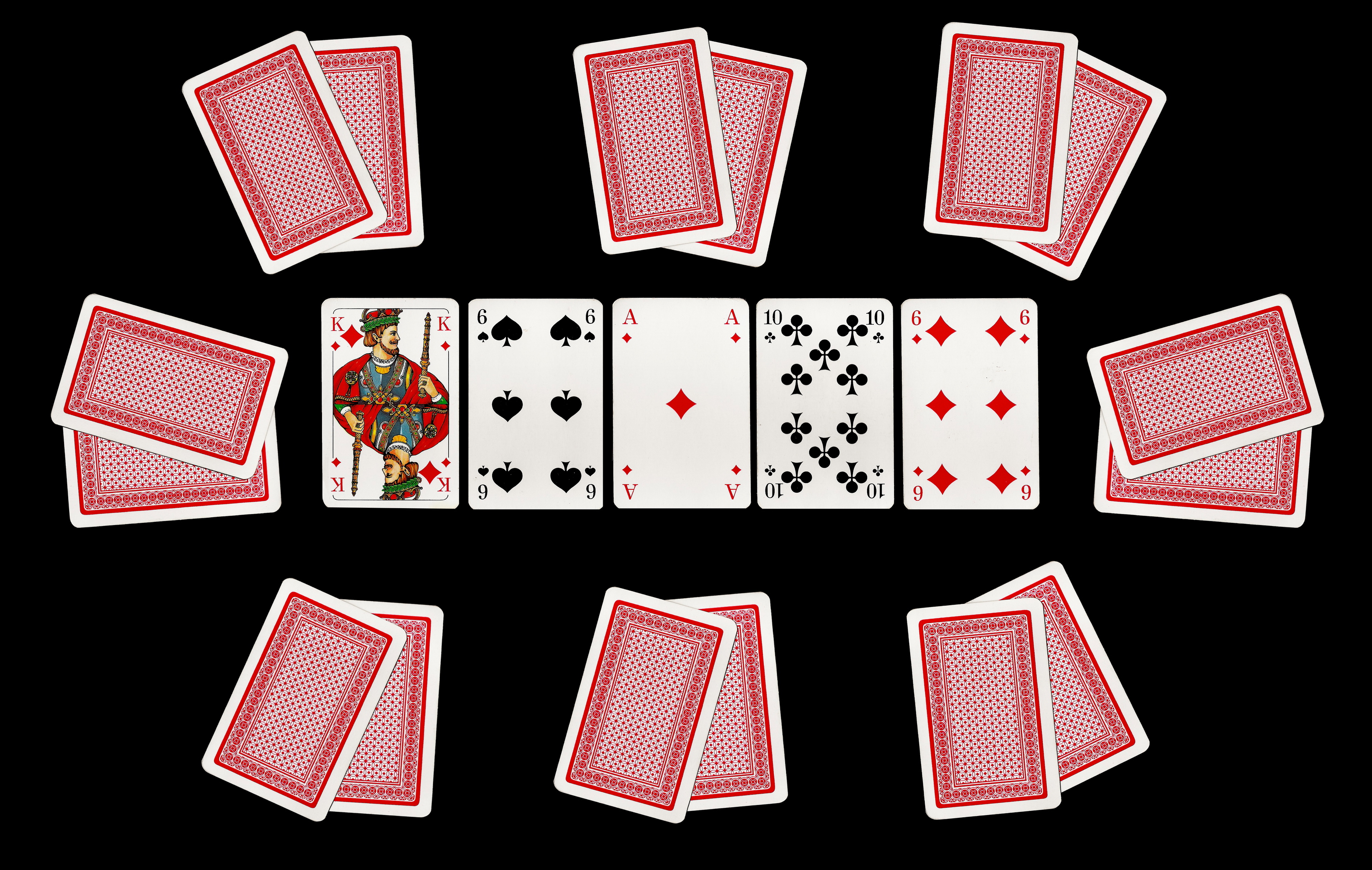|
Desmoche
Desmoche (played in Nicaragua as conquién, with slight variations) is a popular rummy card game usually played for small stakes which closely resembles other games in the rummy family, like Conquian and gin rummy, more than poker.Roger N. Lancaste''Life is hard: machismo, danger, and the intimacy of power in Nicaragua'' pg. 193 University of California Press (2004) It was probably devised in Nicaragua in the first half of the 20th century. Rules Object The object of desmoche is to play, in either runs or sets, exactly ten cards on the table. The game is played by 2, 3 or 4 players with a standard deck of 52 playing cards. Deal Any player may start out as the dealer, which then rotates from round to round in a counterclockwise fashion. The player on the dealer's right may cut the deck before the dealer deals the cards face-down starting with the player on the right and continuing until each player receives nine cards. Cards that are not dealt remain in the deck, which ... [...More Info...] [...Related Items...] OR: [Wikipedia] [Google] [Baidu] |
Conquian
Conquian, Coon Can or Colonel (the two-handed version) is a rummy-style card game. David Parlett describes it as an ancestor to all modern rummy games, and a kind of proto- gin rummy. Before the appearance of gin rummy, it was described as "an excellent game for two players, quite different from any other in its principles and requiring very close attention and a good memory to play it well".Foster (1897), p. 486. History The game originated in Mexico in the mid-1800s. Court records published in 1861 suggest that Conquian was well established there in the 1850s, and this is reinforced by an 1857 account of life in Mexico City. Later, it is recorded in the 1880s in Mexico being played alongside Tuti, Malilla de Campo, Mus and Rentoy. It continued to be popular into the early 20th century, Mexican politician and military leader, Gonzalo Santos, recalling that "before the Revolution 910–1920we had a good life. We lived out there in Tampamolón and did nothing other than pla ... [...More Info...] [...Related Items...] OR: [Wikipedia] [Google] [Baidu] |
Rummy
Rummy is a group of games related by the feature of matching playing cards, cards of the same rank or sequence and same suit. The basic goal in any form of rummy is to build ''Meld (cards), melds'' which can be either Set (cards), sets (three or four of a kind of the same rank) or Run (cards), runs (three or more sequential cards of the same suit) and either be first to Go out (cards), go out or to amass more points than the opposition. Origin There are two common theories about the origin of rummy, attributing its origins in either Mexico or China in the nineteenth century. The first is that it originated in Mexico around the 1890s in a game described as Conquian in R.F. Foster's book ''Foster's Complete Hoyle'', which was played with a 40 card Spanish deck and had melding mechanics. The second is that Rummy originated in Asia, and that Rummy was the result of a Mahjongg, Mahjong variant named Kun P'ai that was Westernized as Khanhoo by W.H. Wilkinson in 1891. Games schola ... [...More Info...] [...Related Items...] OR: [Wikipedia] [Google] [Baidu] |
Gin Rummy
Gin Rummy, or simply Gin, is a two-player card game variant of Rummy. It has enjoyed widespread popularity as both a social and a gambling game, especially during the mid twentieth century, and remains today one of the most widely played two-player card games. History Gin Rummy was created in 1909 by Elwood T. Baker and his son C. Graham Baker. The game remained local to New York until 1941, when it was publicized throughout the United States after becoming a Hollywood fad. In 1947, a survey by an association of U.S. playing card manufacturers concluded that the number of people who learned Gin Rummy during World War II was equal to the number that learned to play pinochle, cribbage, poker, and bridge combined. Magician and writer John Scarne believed Gin Rummy to have evolved from 19th-century whiskey poker (a game similar to Commerce, with players forming poker combinations) and to have been created with the intention of being faster than standard Rummy but less spontaneous ... [...More Info...] [...Related Items...] OR: [Wikipedia] [Google] [Baidu] |
French-suited
French-suited playing cards or French-suited cards are cards that use the French suits of (clovers or clubs ), (tiles or diamonds ), (hearts ), and (pikes or spades ). Each suit contains three or four face/court cards. In a standard 52-card deck these are the ( knave or jack), the ( lady or queen), and the (king). In addition, in Tarot packs, there is a (knight) ranking between the queen and the jack. Aside from these aspects, decks can include a wide variety of regional and national patterns, which often have different deck sizes. In comparison to Spanish, Italian, German, and Swiss playing cards, French cards are the most widespread due to the geopolitical, commercial, and cultural influence of France, the United Kingdom, and the United States in the 19th and 20th centuries. Other reasons for their popularity were the simplicity of the suit insignia, which simplifies mass production, and the popularity of whist and contract bridge. The English ... [...More Info...] [...Related Items...] OR: [Wikipedia] [Google] [Baidu] |
Counterclockwise
Two-dimensional rotation can occur in two possible directions or senses of rotation. Clockwise motion (abbreviated CW) proceeds in the same direction as a clock's hands relative to the observer: from the top to the right, then down and then to the left, and back up to the top. The opposite sense of rotation or revolution is (in Commonwealth English) anticlockwise (ACW) or (in North American English) counterclockwise (CCW). Three-dimensional rotation can have similarly defined senses when considering the corresponding angular velocity vector. Terminology Before clocks were commonplace, the terms " sunwise" and "deasil", "deiseil" and even "deocil" from the Scottish Gaelic language and from the same root as the Latin "dexter" ("right") were used for clockwise. " Widdershins" or "withershins" (from Middle Low German "weddersinnes", "opposite course") was used for counterclockwise. The terms clockwise and counterclockwise can only be applied to a rotational motion once a side ... [...More Info...] [...Related Items...] OR: [Wikipedia] [Google] [Baidu] |
Gambling
Gambling (also known as betting or gaming) is the wagering of something of Value (economics), value ("the stakes") on a Event (probability theory), random event with the intent of winning something else of value, where instances of strategy (game theory), strategy are discounted. Gambling thus requires three elements to be present: consideration (an amount wagered), risk (chance), and a prize. The outcome of the wager is often immediate, such as a single roll of dice, a spin of a roulette wheel, or a horse crossing the finish line, but longer time frames are also common, allowing wagers on the outcome of a future sports contest or even an entire sports season. The term "gaming" in this context typically refers to instances in which the activity has been specifically permitted by law. The two words are not mutually exclusive; ''i.e.'', a "gaming" company offers (legal) "gambling" activities to the public and may be regulated by one of many gaming control boards, for example, the ... [...More Info...] [...Related Items...] OR: [Wikipedia] [Google] [Baidu] |
Poker
Poker is a family of Card game#Comparing games, comparing card games in which Card player, players betting (poker), wager over which poker hand, hand is best according to that specific game's rules. It is played worldwide, with varying rules in different places. While the earliest known form of the game was played with just 20 cards, today it is usually played with a standard 52-card deck, although in countries where short packs are common, it may be played with 32, 40 or 48 cards.Parlett (2008), pp. 568–570. Thus poker games vary in deck configuration, the number of cards in play, the number Poker dealer, dealt face up or face down and the number Community card poker, shared by all players, but all have rules that involve one or more rounds of Betting in poker, betting. In most modern poker games, the first round of betting begins with one or more of the players making some form of a forced bet (the ''blind (poker), blind'' or ''ante''). In standard poker, each player bets a ... [...More Info...] [...Related Items...] OR: [Wikipedia] [Google] [Baidu] |
Meld (cards)
In card games, a meld is a set of matching cards, typically three or more, that earn a player points and/or allow them to deplete their hand. Melds typically come in sequences of ascending cards belonging to the same suit known as '' runs'' () or ''sets/groups'' of cards of identical rank (). Other ones may be ''marriage'' (e.g. K and Q) and ''bezique'' (Q and J). Melding is typical in games of the rummy family, such as canasta Canasta (; Spanish language, Spanish for "basket") is a card game of the rummy family of games believed to be a variant of 500 rum. Although many variations exist for two, three, five or six players, it is most commonly played by four in two par ... and gin. It is also used in other games such as mahjong. Melds are also made in some trick-taking games, such as pinochle and bezique.Parlett (2008), pp. 287-291, 295-296. See also * Run (cards) * Set (cards) References Bibliography * Parlett, David. ''The Penguin Book of Card Games''. Lond ... [...More Info...] [...Related Items...] OR: [Wikipedia] [Google] [Baidu] |
Set (cards)
In card games, a set or group is a scoring combination consisting of multiple playing cards, usually of the same rank.Parlett (2008) p. 489. Depending on the game, a set may consist of two cards of equal rank (a "pair") as in Bieten, three of a kind as in poker, or more. Description Sets are one of the two types of meld that may be used in games where melding is part of the play; the other being a run or sequence. A set or group comprises 3 or 4 cards of the same rank and, usually, different suits. A prial, pair royal, gleek or triplet is a set of 3 cards of equal rank and a quartet or, in some older games, a mournival, is one of four cards of the same rank.Parlett (2008), pp. 287, 645. Usually a pair (2 cards of the same rank but different suits) is not counted as a "set"; but some games, such as Bieten or Perlaggen do include pairs as sets. A wild set is one containing wild cards – that is, those cards designated in the rules as being wild, for example, the jokers in ... [...More Info...] [...Related Items...] OR: [Wikipedia] [Google] [Baidu] |
Card Game
A card game is any game that uses playing cards as the primary device with which the game is played, whether the cards are of a traditional design or specifically created for the game (proprietary). Countless card games exist, including families of related games (such as poker). A small number of card games played with traditional decks have formally standardized rules with international tournaments being held, but most are folk games whose rules may vary by region, culture, location or from circle (cards), circle to circle. Traditional card games are played with a ''deck'' or ''pack'' of playing cards which are identical in size and shape. Each card has two sides, the ''face'' and the ''back''. Normally the backs of the cards are indistinguishable. The faces of the cards may all be unique, or there can be duplicates. The composition of a deck is known to each player. In some cases several decks are Shuffling, shuffled together to form a single ''pack'' or ''shoe''. Modern car ... [...More Info...] [...Related Items...] OR: [Wikipedia] [Google] [Baidu] |
Playing Cards
A playing card is a piece of specially prepared card stock, heavy paper, thin cardboard, plastic-coated paper, cotton-paper blend, or thin plastic that is marked with distinguishing motifs. Often the front (face) and back of each card has a Paper#Finishing, finish to make handling easier. They are most commonly used for playing card games, and are also used in magic tricks, cardistry, card throwing, and house of cards, card houses; cards may also be collected. Playing cards are typically palm-sized for convenient handling, and usually are sold together in a set as a deck of cards or pack of cards. The most common type of playing card in the West is the French-suited, standard 52-card pack, of which the most widespread design is the English pattern, followed by the Belgian-Genoese pattern. However, many countries use other, traditional types of playing card, including those that are German-suited, German, Italian-suited, Italian, Spanish-suited, Spanish and Swiss-suited. Tarot ca ... [...More Info...] [...Related Items...] OR: [Wikipedia] [Google] [Baidu] |







